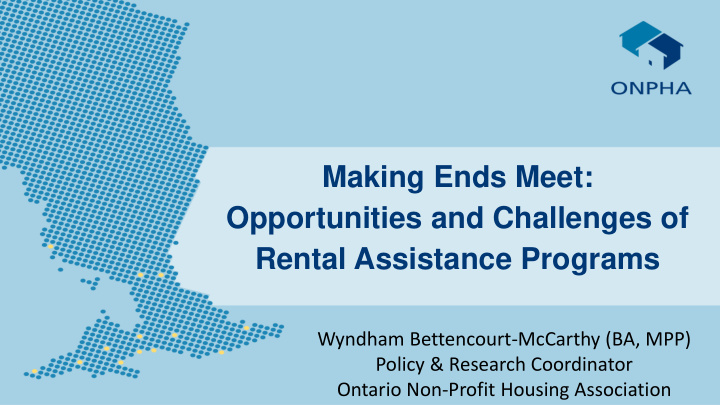



Making Ends Meet: Opportunities and Challenges of Rental Assistance Programs Wyndham Bettencourt-McCarthy (BA, MPP) Policy & Research Coordinator Ontario Non-Profit Housing Association
Ontario’s housing crisis • Increase in low-income renter households + limited rental stock • 1 in 5 renter households spend more than 50% of income on housing costs • Currently 168,000+ households on waiting lists for social housing
What are rental assistance programs? • Signal transition from investment in supply-side housing programs to demand-side • Two kinds of programs: • Rent supplements • Housing allowances • Rental assistance programs support private-sector landlords, rather than social housing providers
Rise in use of rental assistance programs • Programs piloted at local level • LTAHS Update Announcement • Why have programs become more popular?
The advantages of rental assistance programs… • Quick response to households in crisis • Increase freedom and agency, esp. if portable • Can assist more households much faster than new build • No costly backlog of capital repairs
…And the disadvantages • No new rental supply • No enduring public asset, and less cost-effective over time • Challenging for tenants with complex needs • Housing quality and location
What’s the solution? • Not a one-size-fits-all solution to housing affordability issues • Suggested program for households fleeing violence • Subsidies should be permanent, and provide “deep” coverage • But govt. investment is still needed in order to: • Increase supply of affordable rental units in the private market • Build new social housing units
Questions? • Access the report: www.onpha.on.ca • Select “Policy & Research” at the top of the page, and then “ focusON ” • Contact: Wyndham Bettencourt-McCarthy 416-927-9144 ext. 109 wyndham.bettencourt-mccarthy@onpha.org
Recommend
More recommend